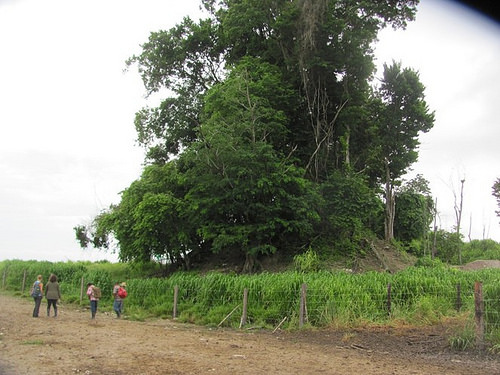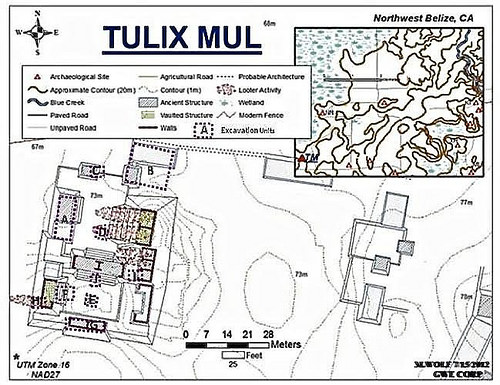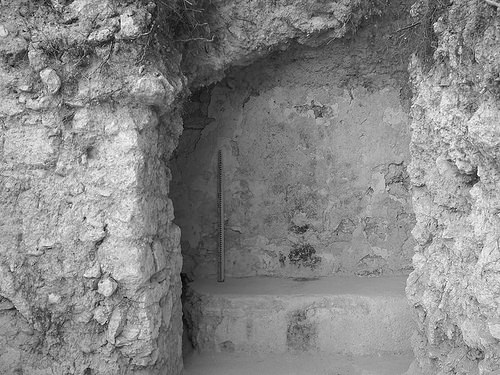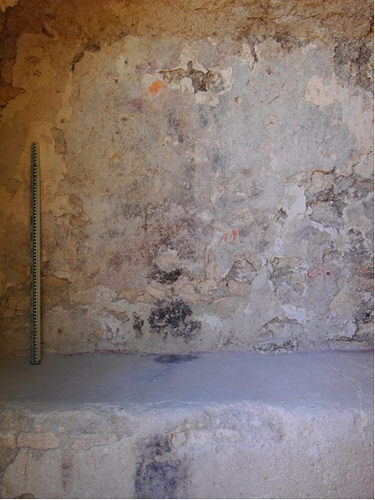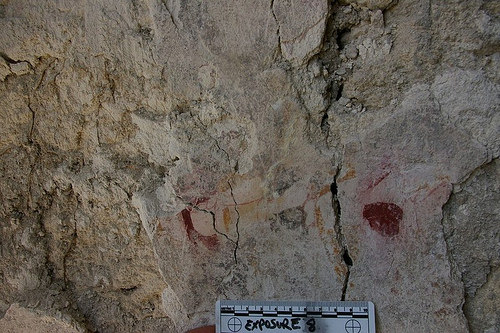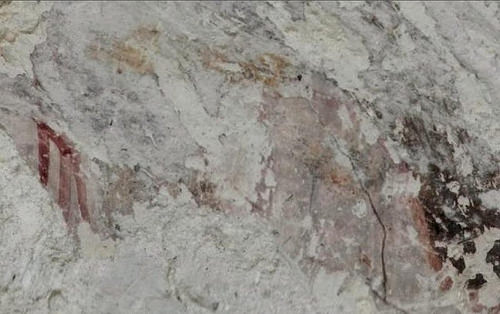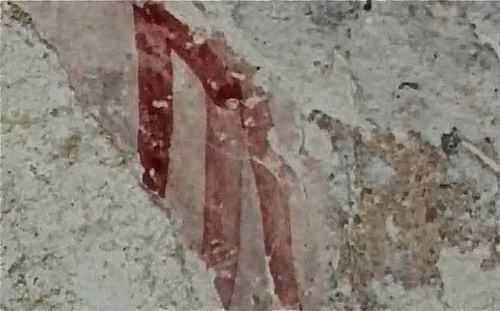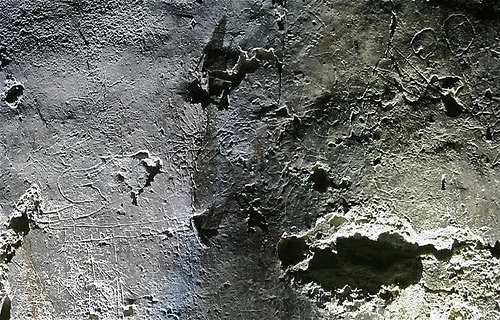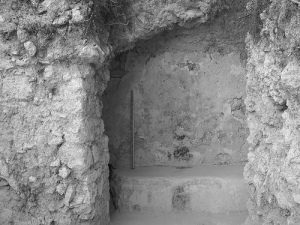
Archaeologists have uncovered some inexplicable finds in a rare case involving the discovery of a Maya wall painting, or mural, at a shrine complex at the ancient site of Tulix Mul in northern Belize.
Buried anciently under a fill of large uncut stones at the beginning of the Maya Late Classic period, a vaulted room within a monumental structure features a plastered wall that hides two successive wall paintings, an unusual find for archaeologists investigating Maya remains. The discovery was first made in 2013 as a team of archaeologists, students and volunteers under the Blue Creek Archaeological Project with the Maya Research Program (MRP) and the University of Texas at Tyler began excavating a structure that showed intrusion by a looter’s trench at the site of Tulix Mul, which is associated with another site known as Nojol Nah, a site where MRP has been excavating for years. Although excavations at this structure revealed the plastered, vaulted room, the biggest prize was the evidence of the wall painting, hidden beneath the plaster. Through time, small fragments had exfoliated from the plaster, revealing the underlying presence of a polychrome, fine-line mural. The mural style appeared generally similar to that found years before by other archaeologists at San Bartolo in Guatemala. Like San Bartolo, there are only a few other known Maya murals found in Central America. Aside from their artistic beauty, they have provided significant new information about Maya art, religious concepts, trade and interaction. The Tulix Mul mural may prove to be equally informative, especially as the site investigators suspect that another rubble-filled room (still unexcavated) may also contain a mural.
_____________________________________________
View of Tulix Mul from the south. Courtesy Maya Research Program
_________________________________________________
Site map of Tulix Mul, with structure featuring the mural indicated as ‘F’. From the 23rd Annual Report (see below), Maya Research Program and Center for Social Science Research.
________________________________________________
Above and below: View into the vaulted room, now excavated, containing the mural, which includes a bench below and in front of it (currently still mostly plasted over by the ancients). Courtesy Maya Research Program
____________________________________________________________
Closeup detail view of mural thus far exposed. Courtesy Maya Research Program
_______________________________________________
But after several seasons of working at the site of the mural, only traces of the mural still remain visible. That’s because of the delicate condition of the murals beneath their overlying plaster shroud, and the effects of the environment decaying the associated material through time. Efforts thus far have produced mixed results.
“We were very pleased to have stabilized and conserved the mural at Tulix Mul,” said Colleen Hanratty, one of the leading archaeologists with the MRP. “But we were not able to reveal more of the secondary mural below the first due to it’s very unstable nature.”
Thus, ongoing work at the mural site will require patience and special attention. Pieta Greaves, the on-site conservator of the mural, reports that because of the fragmentary condition of the visible images, continuing work will “require a specialist to further determine the nature of the images.”*
______________________________________________
Above and below: GigaPan technology, a robotic camera mount system used to create super-high resolution panoramic photographs (based on similar technology used by NASA for the Mars rovers), was applied to create views that made these images of the exposed fragmentary portions of the mural possible. From the 23rd Annual Report (see below), credit Texas A&M University’s Center for Heritage Conservation, GigaPan, and the Maya Research Program and Center for Social Science Research.
______________________________________________
_______________________________________________________________
In the meantime, scientists are scratching their heads over the presence of incised symbolic or image markings on the plaster that covers the wall painting. The ‘graffiti’, as they are calling it, is clearly ancient, as it was obviously incised before the vaulted room containing the mural was filled in by stones at the beginning of the Late Classic period. “Due to the hardness of the plaster and the cleanness of the lines,” reports Greaves, “it is likely that a lithic tool would have been used to create the designs.”*
The images, by interpretation, include an unknown animal and fish, and a crouched figure looking over a representation of the sun at what appears to be a monster. The other images remain without interpretation and it is not known how much of the entire graffiti work has been lost through time by plaster loss.
__________________________________________
A graffiti scene showing what has been interpreted as a possible crouched figure looking over the sun towards a monster. From the 23rd Annual Report (see below), Maya Research Program and Center for Social Science Research.
__________________________________________
In time, however, the underlying mural, once uncovered and more thoroughly studied, could have important implications for understanding Tulix Mul and by extension the behavior of the Maya elite generally. Reported Thomas Guderjan, the Director of the Blue Creek Archaeological Project, the mural “was above and behind a bench viewable from the courtyard and would frame the figure of the noble seated on the bench as he was approached…….a very powerful statement.”*
See more about the wall paintings in the January 2014 issue of Popular Archaeology.
________________________________________________________
*The 23rd Annual Report of the Blue Creek Archaeological Project, Thomas H. Guderjan and C. Colleen Hanratty, Ed., Maya Research Program and the Center for Social Science Research, April 2015.
________________________________________________________
In addition, the latest Popular Archaeology ebook is now available.
______________________________________________
Travel and learn with Far Horizons.
____________________________________________
This richly illustrated ebook version of a recent Popular Archaeology issue includes the following stories: The discovery of the tomb of a previously unknown pharaoh that is shedding light on a lost ancient Egyptian dynasty; how genetics is revolutionizing what we know about human evolution and our prehistoric past; one scholar’s controversial ‘New Chronology’ and how it supports the historicity of the biblical Exodus; how archaeologists are unearthing new history in Williamsburg, Virginia, a seat of British colonial power in 18th century America; the discovery of the remains of a major Roman legionary base in Israel; the unearthing of an ancient Judean fortified settlement in the borderlands between the biblical kingdoms of ancient Judah and the Philistines; and how archaeologists are uncovering evidence of what may have been an important administrative center of Judah during the 8th century BCE. Now available from Amazon.com!

